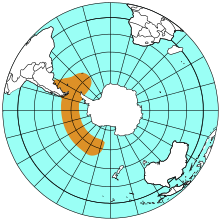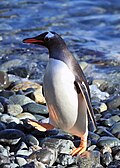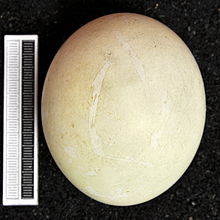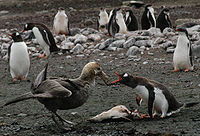Gentoo penguin
| Gentoo penguin | |
|---|---|
| At Brown Bluff, Tabarin Peninsula | |
| Scientific classification | |
| Domain: | Eukaryota |
| Kingdom: | Animalia |
| Phylum: | Chordata |
| Class: | Aves |
| Order: | Sphenisciformes |
| Family: | Spheniscidae |
| Genus: | Pygoscelis |
| Species: | P. papua
|
| Binomial name | |
| Pygoscelis papua (Forster, 1781)
| |

| |
| Distribution of the gentoo penguin | |
The gentoo penguin (
Names
The application of "gentoo" to the penguin is unclear.
It may also be a variation of another name for this bird, "Johnny penguin", with Johnny being the Spanish counterpart of Juanito and sounding vaguely like gentoo.
The specific name papua is a misnomer; in the original description, Johann Reinhold Forster, a naturalist who had circumnavigated the world with Captain James Cook, mistakenly assumed that the species occurred in Papua (New Guinea), the closest gentoos being over 6000 km to the south (on Macquarie Island).[4] No penguins are found in New Guinea.[9] Others trace the error to a "possibly fraudulent claim" in 1776 by French naturalist Pierre Sonnerat, who also alleged a Papuan location for the king penguin despite never having been to the island himself.[10]
Taxonomy
The gentoo penguin is one of three species in the genus Pygoscelis.
There are 4 subspecies recognized by the International Ornithological Congress:[12]
| Image | Subspecies | Distribution |
|---|---|---|
 |
P. p. taeniata (eastern gentoo penguin) (Peale, 1849) | Crozet Islands, Prince Edward Islands, Kerguelen Islands, Heard Island, and Macquarie Island |
 |
P. p. papua (northern gentoo penguin) (Forster, 1781) | Falkland Islands, Martillo Island in the Beagle Channel, and Isla de los Estados (Argentina) |
 |
P. p. ellsworthi (southern gentoo penguin) Murphy, 1947 | the Antarctic Peninsula, the South Orkney Islands, South Shetland Islands and South Sandwich Islands |
 |
P. p. poncetii (South Georgia gentoo penguin) Tyler, Bonfitto, Clucas, Reddy & Younger, 2020 | South Georgia Island |
Although the population on the Kerguelen Islands is tentatively included in taeniata, it may also be a distinct subspecies.[13]
Before 2021, only two subspecies of the gentoo penguin have been recognised: P. p. papua (subantarctic gentoo) and the smaller P. p. ellsworthi (Antarctic gentoo).[14][15] However, a 2020 study suggested that the gentoo penguin be split into a species complex of four morphologically similar but separate species: the northern gentoo penguin (P. papua sensu stricto), the southern gentoo penguin (P. ellsworthi), the eastern gentoo penguin (P. taeniata) and the newly described South Georgia gentoo penguin (P. poncetii).[16][17] The International Ornithological Congress incorporated the results of this study in 2021, but relegated the newly recognized or newly described species to being subspecies of P. papua.[13]
Description

The gentoo penguin is easily recognised by the wide, white stripe extending like a bonnet across the top of its head and its bright orange-red bill. It has pale whitish-pink, webbed feet and a fairly long tail – the most prominent tail of all penguin species. Chicks have grey backs with white fronts. As the gentoo penguin waddles along on land, its tail sticks out behind, sweeping from side to side, hence the scientific name Pygoscelis, which means "rump-tailed".[18]

Gentoo penguins can reach a length of 70 to 90 cm (28 to 35 in),[19][20] making them the third-largest species of penguin after the emperor penguin and the king penguin. Males have a maximum weight around 8.5 kg (19 lb) just before moulting and a minimum weight of about 4.9 kg (11 lb) just before mating. For females, the maximum weight is 8.2 kg (18 lb) just before moulting, but their weight drops to as little as 4.5 kg (9.9 lb) when guarding the chicks in the nest.[21] Birds from the north are on average 700 g (1.5 lb) heavier and 10 cm (3.9 in) longer than the southern birds. Southern gentoo penguins reach 75–80 cm (30–31 in) in length.[22] They are the fastest underwater swimmers of all penguins, reaching speeds up to 36 km/h (22 mph).[23] Gentoos are well adapted to extremely cold and harsh climates.
Breeding


The breeding colonies of gentoo penguins are located on ice-free surfaces. Settlements can be located directly on the shoreline or considerably inland. They prefer shallow coastal areas and often nest between tufts of grass. In South Georgia, for example, breeding colonies are 2 km inland. In colonies farther inland, where the penguins nest in grassy areas, they shift location slightly yearly because the grass becomes trampled over time.
Gentoos breed on many
Two eggs are laid, both weighing around 130 g (4.6 oz). The parents share incubation, changing duty daily. The eggs hatch after 34 to 36 days. The chicks remain in the nests for around 30 days before joining other chicks in the colony and forming crèches. The chicks moult into subadult plumage and go out to sea at around 80 to 100 days.
Diet
Gentoos mainly live on
Gentoos are
Physiology

The gentoos' diet is high in salt, as they eat organisms with relatively the same salinity as seawater, which can lead to complications associated with high sodium concentrations in the body, especially for gentoo chicks. To counteract this, gentoos, as well as many other marine bird species, have a highly developed salt gland located above their eyes that takes the high concentration of sodium within the body and produces a highly saline-concentrated solution that drips out of the body from the tip of the beak.[26]
Gentoo penguins do not store as much fat as Adélie penguins, their closest relative; gentoos require less energy investment when hunting because the net gain of energy after hunting is greater in gentoos than Adélies.[27] As embryos, gentoos require a lot of energy to develop. Oxygen consumption is high for a developing gentoo embryo. As the embryo grows and requires more oxygen, consumption increases exponentially until the gentoo chick hatches. By then, the chick is consuming around 1800 ml O2 per day.[28]
Predators
In the sea,
Conservation status
The population of Pygoscelis papua in the maritime Antarctic is rapidly increasing. Due to regional climate changes, they colonise previously inaccessible territories southwards.As of 2019[update], the IUCN Red List lists the gentoo as least concerned with a stable population trend, although rapid declines in some key areas are believed to be driving a moderate overall decline in the species population. Examples include Bird Island, South Georgia, where the population has fallen by two-thirds over 25 years.[1] Many threats to this species, including pollution, hunting, fishing and human recreational activities continue to affect them.[30][31]
In popular culture
The Linux distribution Gentoo Linux is named after the gentoo penguin. This is a nod to the fact that the penguin is the fastest swimming penguin, as Gentoo Linux aims to be a high-performance operating system.[32]: 383 The mascot for Linux in general is a penguin.
Gallery
-
Adult gentoo confronting a southern giant petrel (Macronectes giganteus) that has killed a chick
-
Gentoo penguin on a nest
-
A gentoo penguin swimming
-
Juvenile gentoos on Petermann Island
-
Gentoo colony on Carcass Island in the Falklands
-
A leopard seal eating an adult gentoo
References
- ^ . Retrieved 18 November 2021.
- ^ Woods, R.W. (1975) Birds of the Falkland Islands, Antony Nelson, Shropshire, UK.
- ISBN 9788120604131.
- ^ ISBN 978-0-547-52761-1.
- Falklandsas the Johnny penguin.
- ^ "gentoo penguin". American Heritage Dictionary of the English Language (5 ed.).
- ISBN 978-1-351-54324-8.
In the 18th century, English-speaking sealers commonly called [the gentoo] the Johnny penguin. The Spanish translation of this was Juanito, which has degenerated into gentoo.
- ISBN 978-0-13-925041-5., a bird of prey that feeds on young gentoo penguins in the Falklands and is called the "Johnny rook".
Sealers called it the "Johnny penguin" or "John penguin." In that incarnation, it seems to have given its name to the striated caracara
- ISBN 978-90-04-34378-8.
- ISBN 978-0-643-10471-6.
- PMID 16519228.
- ^ "Kagu, Sunbittern, tropicbirds, loons, penguins – IOC World Bird List". Retrieved 2022-06-11.
- ^ a b "Subspecies Updates – IOC World Bird List". Retrieved 2022-06-11.
- ^ environment.gov.au. "Pygoscelis papua papua — Gentoo Penguin (subantarctic)". Retrieved 2019-12-12.
- ^ itis.gov. "Pygoscelis papua (J. R. Forster, 1781)". Retrieved 2019-12-12.
- PMID 33391684.
- ISSN 1472-4642.
- ^ "Gentoo penguin videos, photos and facts – Pygoscelis papua". Arkive. Archived from the original on 2009-05-20.
- ^ "Pygoscelis papua (gentoo penguin)". Animal Diversity Web.
- ^ Barham, Peter; Barham, Barbara. "Gentoo Penguin – Pygoscelis Papua". Archived from the original on 2008-09-20. Retrieved 2008-09-23.
- ^ "Gentoo penguin videos, photos and facts – Pygoscelis papua". Arkive. Archived from the original on 2012-07-18.
- ^ "Antarctica fact file wildlife, gentoo penguins". coolantarctica.com.
- ^ "Gentoo penguin". BBC Nature. Archived from the original on 2012-02-05.
- .
Breeding pairs of Pygoscelis papua remained constant throughout the 1996/1997 breeding season. Males observed attempting to breed outside of their original breeding pair were violently ejected from the colony.
- ^ a b c "Pygoscelis papua (gentoo penguin)". Animal Diversity Web. 2011. Archived from the original on 2023-10-05. Retrieved 2024-04-16.
- PMID 14443123.
- S2CID 17563166.
- .
- ^ February 2014 observation and photo report by Robert Runyard, translator for INACH (Chilean Antarctic Institute).
- ^ International), BirdLife International (BirdLife (2019-08-28). "IUCN Red List of Threatened Species: Pygoscelis papua". IUCN Red List of Threatened Species. Retrieved 2021-05-25.
- S2CID 253816909.
- ISBN 978-0-470-28706-4.
This article incorporates text from the
External links
- 70South – more info on the gentoo penguin
- Gentoo penguin on PenguinWorld
- Gentoo penguins from the International Penguin Conservation website
- www.pinguins.info: information about all species of penguins
- Gentoo penguin images
- Gentoo penguin webcam from the Antarctic – worldwide first webcam with wild penguins; photo quality
- gentoo-penguin/pygoscelis-papua Gentoo penguin media from ARKive








